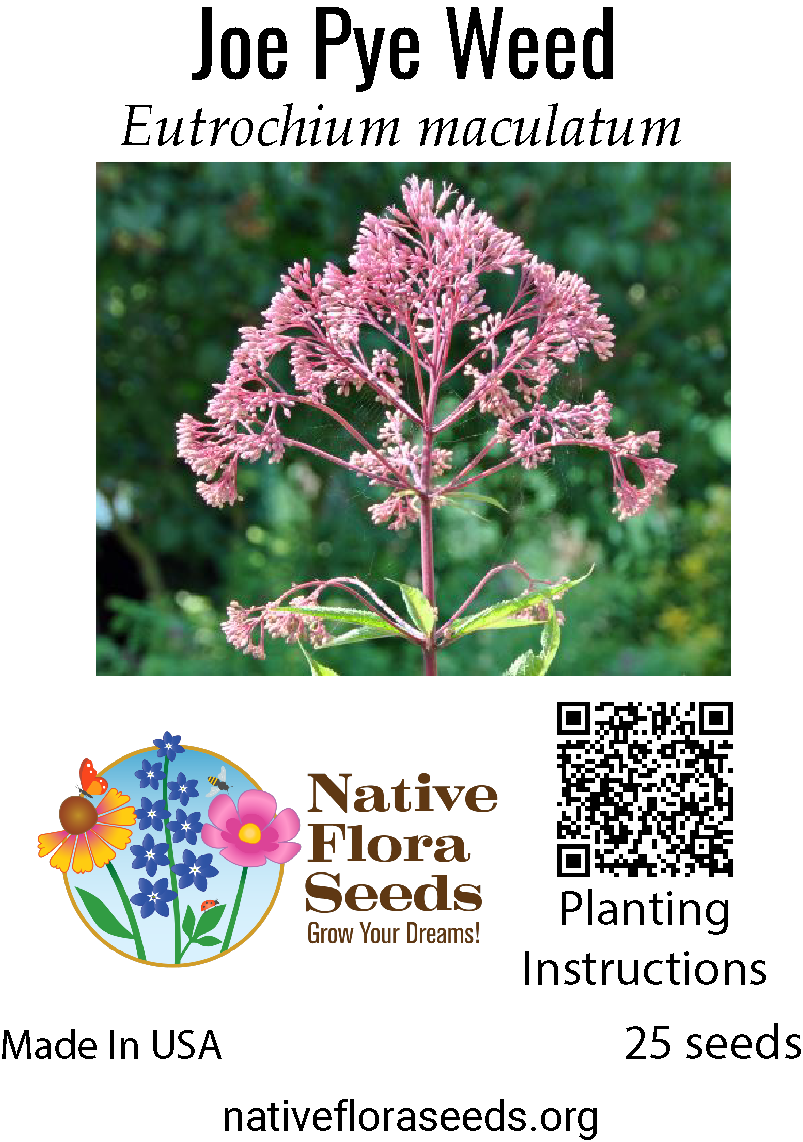Joe Pye Weed
Planting Instructions
Here is a complete planting guide for Eutrochium maculatum (Spotted Joe Pye Weed) for both direct outdoor sowing (fall or spring) and indoor seed starting for spring transplanting, customized for conditions across the USA.
🌿 Eutrochium maculatum Planting Instructions
Common Name: Spotted Joe Pye Weed
Plant Type: Long-lived perennial wildflower
Native Range: Eastern and central United States and Canada
Pollinator Value: Exceptional – highly attractive to bees, butterflies, and other beneficial insects, especially monarchs and swallowtails
☀️ Site Selection & Sunlight Requirements
Sunlight:
Full sun to partial sun (at least 4–6 hours daily).
Best flowering occurs in full sun, but tolerates part shade.
Soil Preferences:
Moist to wet soils preferred – ideal for rain gardens, pond edges, moist meadows, ditches, low areas.
Tolerates clay, loamy, and rich soils.
Soil pH: Slightly acidic to neutral (pH 5.5–7.0)
🌱 Soil Preparation
Loosen soil to a depth of 6–10 inches.
Remove grass, weeds, and debris.
Mix in organic matter (compost or leaf mold) if soil is compacted or poor in nutrients.
If soil tends to dry out, consider adding moisture-retentive organic material.
🌾 Direct Sowing Outdoors – Fall or Spring
Fall Sowing (Recommended)
When: Late fall, after the first hard frost, before ground freezes.
Why: Takes advantage of natural cold stratification over winter.
How:
Sow seeds directly on the surface of prepared soil.
Press seeds gently into the soil.
Do not bury deeply – seeds require light exposure for germination.
Cover lightly with fine mulch or soil (no more than 1/16 inch).
Let snow and rain handle moisture and stratification over winter.
Spring Sowing
When: Early spring, after last frost, or after pre-stratification indoors.
Stratification Required: Yes — if sowing in spring, pre-stratify seeds indoors (see below).
How:
Sow on the soil surface and press seeds in gently.
Lightly cover if needed, but allow light exposure.
Keep soil consistently moist during germination.
Germination Time: Usually 14–30 days, depending on temperature and moisture.
🌱 Indoor Seed Starting for Spring Transplanting
When to Start Indoors: 8–10 weeks before last frost
Stratification Needed: Yes – seeds require cold moist stratification for 30–60 days
How: Mix seeds with damp sand, vermiculite, or peat in a sealed plastic bag.
Refrigerate at 34–40°F for at least 4–8 weeks.
Scarification: Not required
Sowing Indoors:
After stratification, sow seeds on the surface of moist seed-starting mix.
Lightly press into soil surface.
Do not cover deeply – seeds need light to germinate.
Maintain indoor temps of 65–75°F.
Use humidity dome or plastic wrap to retain moisture.
Germination in 2–4 weeks after stratification.
Transplanting Outdoors: Harden off seedlings and transplant after last frost into prepared moist soil.
💧 Watering
During germination: Keep soil consistently moist – do not let it dry out.
After establishment: Prefers moist conditions, but tolerates short dry periods.
Best growth in areas with consistent moisture (rain gardens, low swales, near irrigation zones).
✂️ Maintenance Tips
Deadhead to extend bloom or prevent excessive self-seeding (optional).
Tall growth (4–7 feet) – may require staking in windy or exposed areas.
Cut back in late fall or early spring to promote healthy regrowth.
Benefits from periodic division every 3–4 years to rejuvenate root crowns.
Excellent for naturalizing and pollinator corridors.
❌ Is it Invasive?
Not considered invasive.
May self-seed lightly, but is not aggressive and is easily controlled.
Well-suited to both managed gardens and wild/native landscapes.
🌼 Other Notes
Pairs beautifully with:
Liatris spicata, Asclepias incarnata, Monarda fistulosa, Coreopsis, Rudbeckia, Solidago.
Ideal for:
Pollinator gardens, riparian buffers, restoration projects, meadow gardens, rain gardens.
Provides late-season nectar when many other native plants have finished blooming



